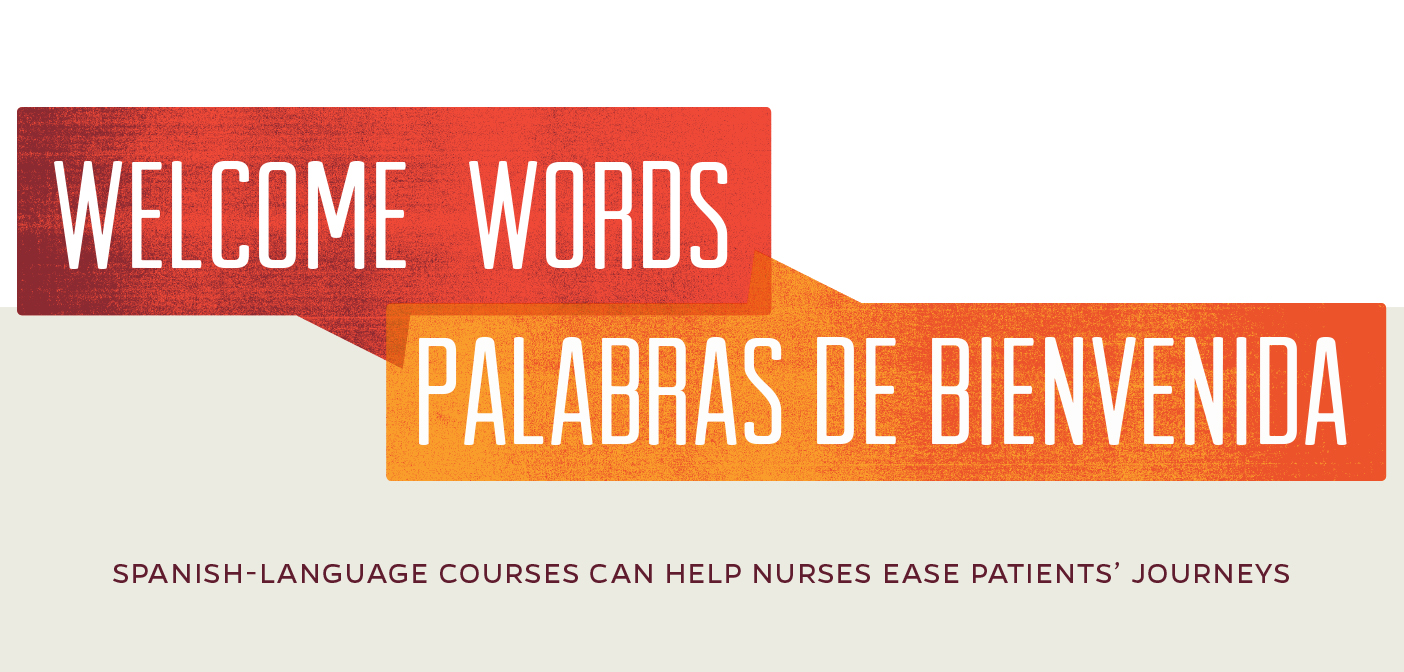Spanish-language courses can help nurses ease patients’ journeys
In 1996, faculty lecturer Sarah Dutton, studying abroad in Mexico, went to a local hospital to get treatment for a second-degree sunburn. Although she spoke some Spanish, she still felt vulnerable about seeking care in another country. “When we come for medical care, we’re in pain, we’re on medication, we’re confused, we’re angry, we’re altered from our normal selves,” she says. “Add a language barrier to that, and it’s very difficult. There was such a divide between me and my doctor. If someone had said, ‘Hi, how are you?’ … just spoken in my own language, I would have felt better.”
Research has shown that language barriers between patients and providers increase the risk of medical errors and decrease patient satisfaction. Working with a certified interpreter—to facilitate patient-provider conversations—is the best way to improve outcomes for limited English proficiency (LEP) patients. But healthcare providers can also improve the patient experience for their LEP patients, particularly Hispanics and Latinos, who make up 17 percent of the U.S. population, by learning about language and culture themselves.Since 2002, Dutton has been preparing nurses (as well as physicians and public health professionals) to break down these language barriers. At the School of Nursing, her beginner, intermediate, and advanced Spanish classes cover medical terminology and cultural competence. This year, she will also unveil “Beginning Spanish for Medical Personnel,” a noncredit class taught through a combination of online and in-person lessons for registered nurses and healthcare providers who are already working with patients. Through her Spanish-language classes, instructor Sarah Dutton helps caregivers “develop that capacity for connection.” “There is such a need—and it’s only increasing—for providers who can bridge language gaps and create more positive patient experiences,” she says.
“There is such a need—and it’s only increasing—for providers who can bridge language gaps and create more positive patient experiences.”
—Sarah Dutton, Instructor
At the Johns Hopkins Hospital, the number of LEP patients has skyrocketed in the past four years. In 2013, there were nearly 50,000 requests for interpretation services, more than double the number of requests in 2009. Fifty-seven percent of them were for Spanish-speaking patients.The Civil Rights Act of 1964, which prohibits discrimination based on national origin, requires interpreters for hospitals that receive federal funding. Johns Hopkins Medicine International’s thriving Language Access Services’ department (LAS) has 18 full-time interpreters and 45 floaters—many of whom have passed a rigorous two-year testing period to become certified—who interpret in-person and by phone and video in 111 languages 24 hours a day.
So where do nurses come in?
Knowing some Spanish words and phrases helps “nurses connect with their [Hispanic and Latino] patients,” says Susana Velarde, administrator for LAS. This improves the care experience for both patients and providers, she adds.
A small 2008 study published in the Journal of Emergency Nursing came to the same conclusion: Of five emergency room nurses who treated Mexican American patients, the only one to report developing a relationship with those patients spoke some Spanish. Building this rapport with patients can lead to better outcomes, too: In a 2014 Journal of Cancer Education study of Latina and Caucasian women, patients who had good experiences with their healthcare providers were more likely to be positive about future screenings and treatments.
To “teach [healthcare providers] to develop that capacity for connection,” Dutton says, the classes cover enough Spanish vocabulary for nurses to react to conversations in a medical setting. To do this, they learn to use the theory of circumlocution, or speaking around a word. For example, if they don’t know the word “otorrinolaringólogo” (otolaryngologist), they can say “un medico para enfermedades de los oídos, la naríz y la garganta” (a doctor for illnesses of the ears, nose, and throat).Although most will still work with interpreters, nurses who take the classes will also be able to ask a variety of questions, collect basic biographical information, and tell patients how long they have to wait in Spanish. “Even those basic questions [and statements] are a huge bridge in terms of that moment of vulnerability for patients,” Dutton says.
Schruti Thomas, RN, an operating room nurse at the Johns Hopkins Hospital who recently completed the first beginner Spanish class (there are two beginner levels), agrees that knowing only a few phrases can help put Spanish-speaking patients at ease. “They’re scared going to sleep in the OR,” she says. From the class, she has learned “what you say to calm [patients] down when they go to sleep or when they are waking up from anesthesia.” The courses offer enough Spanish vocabulary for nurses to react to conversations in a medical setting. To deliver the classes, the School of Nursing works with interpreters from LAS, a partnership that gives nursing students an opportunity to practice their speaking skills before working with patients. During a final exam, all students take health histories for an interpreter, who plays the role of a patient. Intermediate students also shadow interpreters to get a behind-the-scenes look at their jobs.
Although she has worked with interpreters as a nurse, public health nursing and nursing midwifery master’s student, Stephanie Estes, RN, who recently completed the intermediate Spanish class, says that shadowing one made her realize that their jobs go beyond interpreting. The interpreter accompanied one patient during several appointments with different providers, even reminding the patient when she had to make new appointments at the desk. “She was like a cultural broker,” Estes says. “She was able to navigate the system for this patient who may have gotten lost in it otherwise.”Along with working with interpreters, some former students still use their language and cultural competence skills on a daily basis. As a nurse practitioner with Weill Cornell Internal Medicine Associates at New York Presbyterian Hospital, Anthony Pho, BSN ’08, MSN/MPH ’11, RN, works with a patient population that is 30 to 40 percent Spanish-speaking. Growing up in a more formal Asian culture, he might not have automatically known that these patients prefer a more open communication style. He says it’s not uncommon for them to Dutton seeks to provide students not only with language skills but with cultural knowledge. hug and kiss him, like they would a family member. Knowing this, Pho aims to build trust with these patients, often asking them about their families.
Because he makes this connection with them, “[my patients] are more willing to be honest about what is happening in their lives,” Pho says. “They also trust me more with their medical care.”
Cultural competence and sensitivity are a major part of the curriculum for each Spanish class. Wanting her students to feel comfortable working with patients from many cultures, Dutton teaches Kleinman’s Questions. Developed by Harvard physician Arthur Kleinman, these eight, open-ended questions—such as “What do you fear most about your sickness?” and “What do you think caused the problem?”—are designed to help providers learn their patients’ cultural beliefs, thus giving them a better idea of whether they will be comfortable with treatments.
Dutton also covers specific Hispanic and Latino cultural beliefs, such as the concept of the mal de ojo, or “the evil eye.” Say a mother visits a clinic with her sick child. Trying to develop a rapport, a nurse compliments the child, calling him “strong” and “beautiful.” But the mother suddenly looks uncomfortable. That’s because some in the Latino culture believe that children who receive compliments are more susceptible to illnesses from the mal de ojo. Nurses familiar with this belief system will know to touch the baby’s shoulder or his blanket—a gesture thought to offer protection from the evil eye—while offering compliments.
Then there is the Spanish naming system, which can feature compound first and last names and (as with some other non-English naming constructions) be misunderstood by the unfamiliar. Thus, patients can get logged into the hospital’s system under different names and numbers, a mistake that can have huge implications for billing, insurance, and patient outcomes.
Nurses also learn about the economic and social challenges that Spanish-speaking patients could be facing. They may fear deportation; may be struggling financially; may be separated from families who stayed in their home countries.Many also have very little, if any, experience with medicine. “Coming [to Hopkins] is like landing on the moon,” says Robert Stucky, a Spanish language interpreter and a frequent volunteer during Dutton’s final exams. “Being sensitive to that is huge.”
“You can have all the medical information that patients need to be well, but if you cannot communicate it effectively it doesn’t matter.”
—Sarah Dutton, Instructor
Arming her students with language skills and cultural knowledge so they can improve patient care is Dutton’s goal. “You can have all the medical information that patients need to be well, but if you cannot communicate it effectively, it doesn’t matter,” she says. Through these classes, “we’re getting this wealth of information to providers so they can effect better outcomes and improve the quality of life for their patients.”For more information, visit nursing.jhu.edu/spanish

